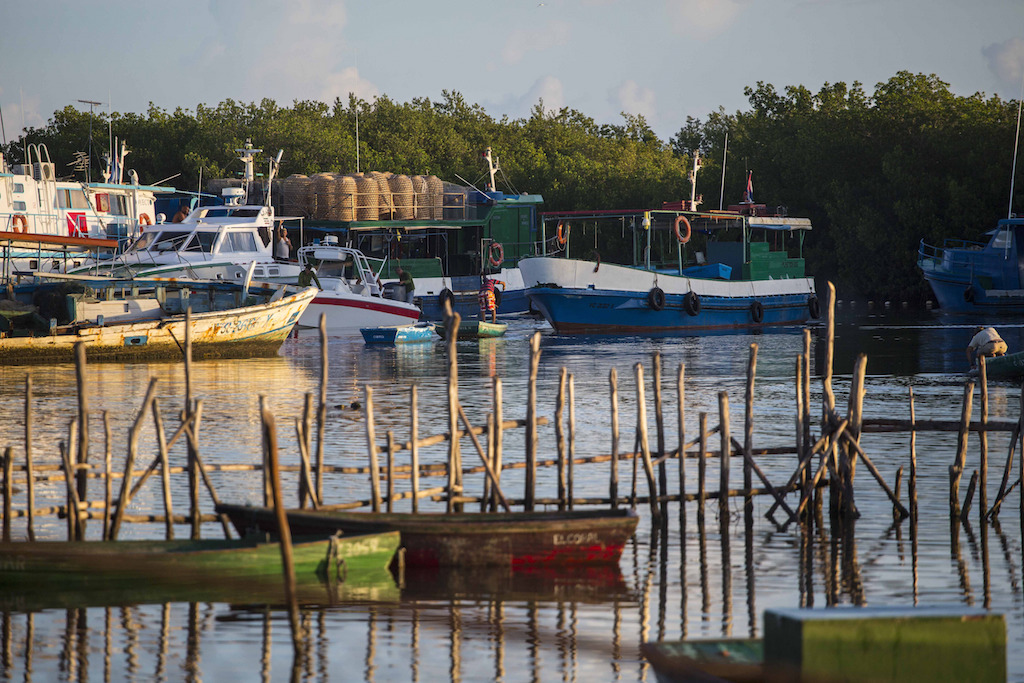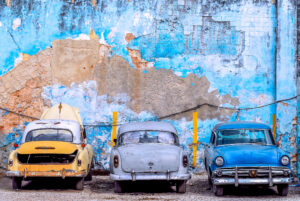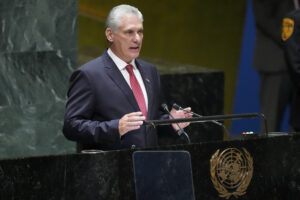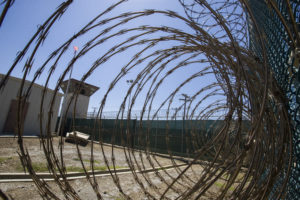Hurricane Irma Leaves a Trail of Ruin Across Caribbean
The death toll for the Category 5 storm passes 20 and is expected to rise as rescuers reach some of the hardest-hit areas. On Thursday, ahead of Hurricane Irma, fishermen secure their boats in Caibarien, on the north coast of central Cuba. (Desmond Boylan / AP)
On Thursday, ahead of Hurricane Irma, fishermen secure their boats in Caibarien, on the north coast of central Cuba. (Desmond Boylan / AP)
CAIBARIEN, Cuba—Hurricane Irma scraped Cuba’s northern coast Friday on a course toward Florida, leaving in its deadly wake a ravaged string of Caribbean resort islands strewn with splintered lumber, corrugated metal and battered cars.
The death toll in the Caribbean stood at at least 21 and was expected to rise as rescuers reached some of the hardest-hit areas. And a new danger lay on the horizon to the east: Hurricane Jose, a Category 4 storm with 150 mph winds that could punish some of the devastated areas all over again.
“I don’t think it takes a rocket scientist to know that further damage is imminent,” said Inspector Frankie Thomas of the Royal Police Force of Antigua and Barbuda.
Irma weakened from a Category 5 to a still-fearsome Category 4 on Friday morning with winds near 150 mph (240 kph).
The hurricane smashed homes, schools, stores, roads and boats on Wednesday and Thursday as it rolled over some of the world’s most famous beach paradises, including St. Martin, St. Barts, St. Thomas, Barbuda and Anguilla.
It knocked out power, water and telephone service, trapped thousands of tourists, and stripped the trees of leaves, leaving an eerie, blasted-looking landscape. Looting was reported on St. Martin, and a curfew was imposed in the U.S. Virgin Islands.
It was a glimpse of what could lie ahead for Florida early Sunday, which braced for what many fear could be the long-dreaded Big One, with the Miami metropolitan area of 6 million in the crosshairs.
Florida residents and tourists faced gas shortages and gridlock on inland highways as a half-million people in Miami-Dade County were ordered to clear out.
Irma rolled past the Dominican Republic and Haiti and battered the Turks and Caicos Islands early Friday with waves as high as 20 feet (6 meters). Communications went down as the storm slammed into the islands, and the extent of the devastation was not immediately clear.
The hurricane also spun along the northern coast of Cuba, where tens of thousands of people were being moved to safety, including thousands of tourists along a shoreline dotted with all-inclusive resorts.
U.S., Dutch, French and British authorities used warships and military planes to rush food, water and troops to the stricken zone.
On the island of St. Thomas, part of the U.S. Virgin Islands, power lines and towers were toppled, leaves were stripped off plants and trees, a water and sewage treatment plant was heavily damaged, and the harbor was in ruins, along with hundreds of homes and dozens of businesses.
Thousands of tourists were trapped on St. Martin, St. Barts, and the Virgin Islands in the path of Jose, which threatened to strike as early as Saturday.
Some of the Irma-ravaged islands could see tropical-storm force winds and heavy rain from Jose, said Jeff Masters of the private forecasting service Weather Underground.
“It’s insult added to injury definitely, but nothing compared to what they already went through,” Masters said. “It’s going to hamper relief efforts, so that’s a big deal.”
On St. Martin, which is divided between Dutch and French control, cafes and shops were swamped, and the storm left gnarled black branches stripped of leaves. Battered cars, corrugated metal, plywood, wrought iron and other debris covered street after street. Roofs were torn off numerous houses.
There was little left of the Hotel Mercure but its sign, painted on a still-standing wall.
The cleanup was already underway for some. One man chopped at the branches of a bare tree. Another heaved what appeared to be furniture stuffing onto a pile. People sat in chairs outside a hospital, waiting to be seen.
“We’ve had quite some looting that has taken place, unfortunately,” said William Marlin, prime minister of the Dutch side of the island.
Marlin said that in the aftermath of such a disaster, “people become kind of hopeless and there is no communication.”
The dead included 11 on St. Martin and St. Barts, four in the U.S. Virgin Islands, four in the British Virgin Islands and one each on Anguilla and Barbuda.
The hospital on St. Thomas was destroyed and dozens of patients were being evacuated to St. Croix and Puerto Rico by the U.S. Coast Guard.
Gov. Kenneth Mapp of the U.S. Virgin Islands imposed a 6 p.m. curfew. The primary focus for now is “making sure people have meals, water and shelter,” Mapp said. “An event of this magnitude is very chilling.”
Fox reported from Miami. Associated Press writers Ian Brown in St. Thomas, U.S Virgin Islands; Evens Sanon in Port-au-Prince, Haiti; Danica Coto in San Juan, Puerto Rico; Ezequiel Lopez Abiu in Santo Domingo, Dominican Republic; Anika Kentish in St. John’s, Antigua; Seth Borenstein in Washington; Michael Weissenstein in Havana; and Samuel Petrequin in Paris contributed to this report.
Your support matters…Independent journalism is under threat and overshadowed by heavily funded mainstream media.
You can help level the playing field. Become a member.
Your tax-deductible contribution keeps us digging beneath the headlines to give you thought-provoking, investigative reporting and analysis that unearths what's really happening- without compromise.
Give today to support our courageous, independent journalists.









You need to be a supporter to comment.
There are currently no responses to this article.
Be the first to respond.